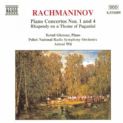Piano Concerto No 4, Op. 40 (Full Score)
Piano Concerto No 4, Op. 40 (Full Score)
* Estimated price converted from UK retail price
First recording of the 1926 original version: Ondine ODE 977-2, by Alexander Ghindin (piano) and the Helsinki Philharmonic Orchestra, conducted by Vladimir Ashkenazy.
Duration: 31 minutes.
The original manuscript of Rachmaninoff’s Piano Concerto No. 4, op. 40, dated ‘January–25 August [1926], New York–Dresden’, is now in the Library of Congress, Washington DC, USA. The first of a group of six performances of the work was given by the composer with the Philadelphia Orchestra conducted by Leopold Stokowski in Philadelphia on 18 March 1927. These performances evidently used manuscript orchestral material whose present location or survival remains undocumented. Before first publication by TAIR in Paris in 1928 the composer carried out a fairly extensive revision of his score, involving both rewriting and cuts, a process to be repeated in 1941 before the (posthumous) issue of the final version by Charles Foley in New York in 1944.
The aim of the present publication is to present the original version of the work as found in the manuscript, unperformed since 1927. The manuscript comprises 171 pages on each of which appears the full instrumentation, even when only one part is playing, together with the composer’s arrangement of the orchestral contribution for a second piano at the foot. Despite the often microscopic orthography, particularly note-heads, the general clarity and accuracy of the manuscript is exemplary; there are only a few places where alteration or rewriting has taken place (usually in the solo part).
Every effort has been made to reproduce the text of the original manuscript faithfully and accurately. Reference to the second piano part at the foot of each page has clarified or confirmed certain readings sometimes rendered doubtful by the composer’s minute handwriting; reference to the printed score of 1928 has also assisted in those places where the two scores agree. Accidentals implied by the composer have been entered where necessary in accordance with current practice. Bowings added in the manuscript (first two movements only) in an unidentified hand have been incorporated in the present score. In the third movement bowings have been transferred from essentially unaltered passages in the 1928 publication, or by analogy; there remain a number of places, however, which of necessity stand unmarked.







